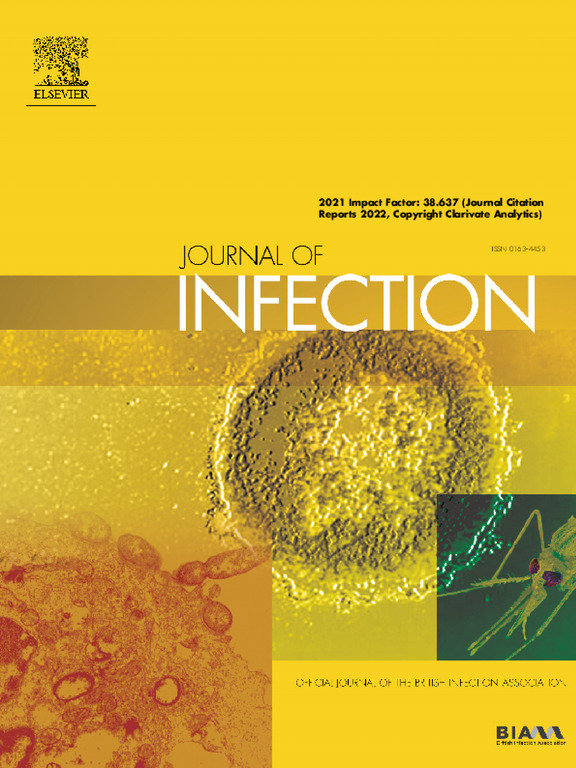Long-term risk of psychiatric disorders in childhood and adolescence following neonatal invasive group B Streptococcus disease—A Danish cohort study
IF 14.3
1区 医学
Q1 INFECTIOUS DISEASES
引用次数: 0
Abstract
Objectives
The long-term risk of child and adolescent psychiatric disorders (PDs) after neonatal invasive group B Streptococcus disease (iGBS) and the modifying factors are poorly understood.
Methods
A population-based matched cohort study, including 1548 infants with iGBS diagnosed during the first 3 months of life from 1997 through 2020 and follow-up until 2022, based on data from Danish national health and administrative registers. A general population comparison cohort of infants without iGBS was randomly sampled and matched 1:10 by sex, the child’s birth year and month, and gestational age (n= 15,345).
Results
The cumulative incidence proportion (CIP) with 95% confidence intervals (CIs) of any PD was 21.1% (95% CI 18.7–23.7) in infants exposed to iGBS (88% sepsis, 12% meningitis) and 16.2% (95% CI 15.5–17.0) in the comparison cohort. The 18-year CIP of PD was higher for infants exposed to iGBS meningitis compared to iGBS sepsis. The adjusted hazard ratio for PD in infants with iGBS was 1.41 (95% CI 1.23–1.62).
Conclusions
iGBS in early infancy is a risk factor for PDs, especially iGBS meningitis. Premature birth, gestational diabetes, and low maternal education increased the risk of any PD further.
Summary
Group B Streptococcus (Streptococcus agalactiae) remains the leading cause of neonatal, invasive disease and is associated with high mortality and risk of neurodevelopmental impairments. Scarce data exist regarding the long-term risk of psychiatric disorders following invasive group B Streptococcus disease in early infancy (iGBS), especially following sepsis. In this Danish national cohort study, we investigated the association of iGBS and the risk of psychiatric disorders until adolescence and early adulthood. We investigated to which extent premature birth, sex (at birth), maternal socioeconomic position or gestational diabetes were modifying the association between iGBS and psychiatric disorders.
Our study found an increased risk of psychiatric disorders persisting into adolescence following iGBS, including both meningitis and sepsis. Specific psychiatric disorders with elevated risk included anxiety, obsessive-compulsive disorder, autism, and attention deficit hyperactivity disorder. Premature birth, maternal gestational diabetes, and low maternal education further increased the risk of any psychiatric disorders, whereas the child’s sex did not.
新生儿侵袭性B组链球菌病后儿童和青少年精神障碍的长期风险——丹麦队列研究
目的:新生儿侵袭性B族链球菌病(iGBS)后儿童和青少年精神障碍(pd)的长期风险及其影响因素尚不清楚。方法:基于丹麦国家卫生和行政登记处的数据,一项基于人群的匹配队列研究,包括1997年至2020年出生后3个月内诊断为iGBS的1,548名婴儿,并随访至2022年。无iGBS婴儿的一般人群比较队列随机抽样,按性别、孩子的出生年月日和胎龄1:10匹配(n= 15,345)。结果:在暴露于iGBS(88%败血症,12%脑膜炎)的婴儿中,任何PD的累积发病率(CIP)与95%置信区间(CIs)为21.1% (95% CI 18.7-23.7),而在比较队列中为16.2% (95% CI 15.5-17.0)。与iGBS败血症相比,暴露于iGBS脑膜炎的婴儿18年PD的CIP更高。iGBS患儿PD的校正危险比为1.41 (95% CI 1.23-1.62)。结论:婴儿期早期iGBS是PDs的危险因素,尤其是iGBS脑膜炎。早产、妊娠期糖尿病和低母亲教育水平进一步增加了任何PD的风险。B族链球菌(无乳链球菌)仍然是新生儿侵袭性疾病的主要原因,并与高死亡率和神经发育障碍风险相关。关于早期婴儿(iGBS)侵袭性B族链球菌病(iGBS)后精神障碍的长期风险,特别是败血症的数据很少。在这项丹麦国家队列研究中,我们调查了iGBS与青春期和成年早期精神疾病风险的关系。我们调查了早产、性别(出生时)、母亲的社会经济地位或妊娠期糖尿病在多大程度上改变了iGBS和精神疾病之间的关联。我们的研究发现,iGBS后持续到青春期的精神疾病风险增加,包括脑膜炎和败血症。高危的特殊精神疾病包括焦虑、强迫症、自闭症和注意缺陷多动障碍。早产、母亲妊娠期糖尿病和母亲受教育程度低会进一步增加任何精神疾病的风险,而孩子的性别则不会。
本文章由计算机程序翻译,如有差异,请以英文原文为准。
求助全文
约1分钟内获得全文
求助全文
来源期刊

Journal of Infection
医学-传染病学
CiteScore
45.90
自引率
3.20%
发文量
475
审稿时长
16 days
期刊介绍:
The Journal of Infection publishes original papers on all aspects of infection - clinical, microbiological and epidemiological. The Journal seeks to bring together knowledge from all specialties involved in infection research and clinical practice, and present the best work in the ever-changing field of infection.
Each issue brings you Editorials that describe current or controversial topics of interest, high quality Reviews to keep you in touch with the latest developments in specific fields of interest, an Epidemiology section reporting studies in the hospital and the general community, and a lively correspondence section.
 求助内容:
求助内容: 应助结果提醒方式:
应助结果提醒方式:


